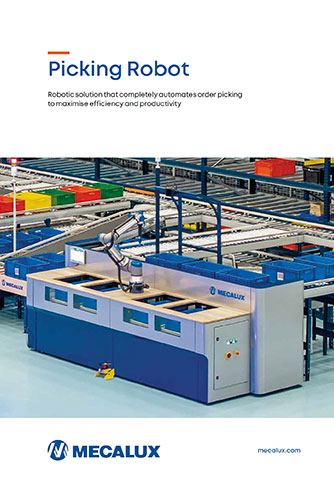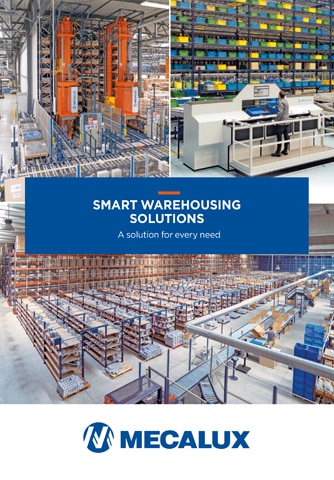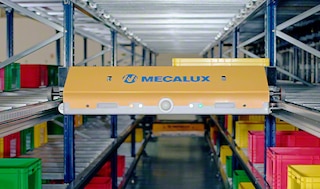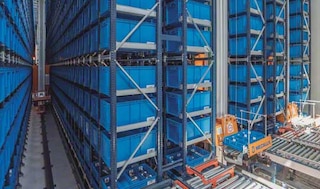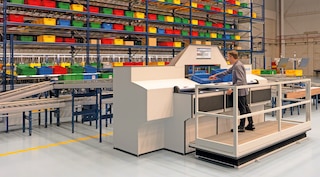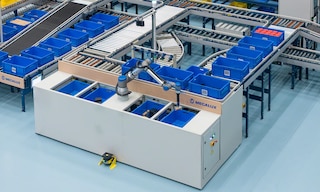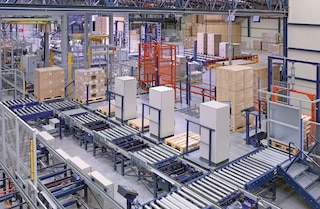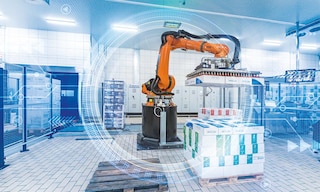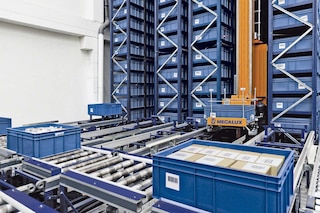Picking Robot
Robotic pick solution that completely automates order picking to maximise efficiency and productivity.
The product
Fully automated picking for fast, accurate and intelligent order fulfilment
The picking robot is a pick and place cobot designed to automate order picking. It picks products from one storage tote or container and places them into another autonomously. Thanks to innovative deep learning-based vision software and a highly versatile gripping device, the robot handles a wide variety of items with absolute precision, regardless of their sizes, shapes or finishes.
Mecalux picking robots are ideal for warehouses that handle a large volume of daily shipments or face high-intensity seasonal peaks in demand. Robotic picking is the ultimate solution to increase productivity, reduce operating costs and maximise order fulfilment efficiency in companies across all sectors, including the e-commerce, pharmaceutical, textile and food industries.
Picking robot advantages
- High throughput: the cobot can achieve up to 1,000 picks/hour. Its operating speed and capacity to work uninterruptedly 24/7 significantly streamline order picking and boost productivity compared to manual solutions.
- Maximum efficiency: goods-to-robot order picking systems minimise the possibility of error and free operators from repetitive tasks.
- Great flexibility: the gripping device adapts to the characteristics of the product to be handled. As a result, the cobot can work with a wide variety of items of different shapes, surface finishes and sizes.
- Absolute accuracy: the vision software instantly calculates and identifies the best pick point for each product according to its attributes and position inside the tote.
- Autonomous operations: thanks to the vision software’s advanced AI algorithms, the robot can pick unknown items without the need for prior training. This ensures immediate adaptation to warehouse inventory and any variations in SKUs.
- Integration and adaptability: the robot is compatible with other automated warehouse systems, such as miniloads and the Shuttle System.
- Enhanced safety: the cobot is capable of detecting any presence in its vicinity and adjusting its working speed, making its environment extremely safe.
- Ease of use and implementation: its intuitive user interface and simple installation ensure a quick system set-up.
Robotic arm applications
Optimised picking operations for companies across all sectors
The robot’s versatility, which allows it to identify, pick and place a wide range of items, makes it well-suited for various requirements. It is an ideal solution for streamlining order fulfilment in scenarios with high product turnover or seasonal peaks in demand.
How does a picking robot work?
Smooth operations for continuous, error-free order picking
The high accuracy and efficiency of Siemens’ SIMATIC Robot Pick AI vision software guarantee reliability in picking. The robotic arm’s versatility and gripping device further enhance the system’s performance.
Components of the robotic order picking system
Mecalux’s innovative order picking robot is a cutting-edge technological solution. It consists of vision software based on deep learning algorithms, a high-performance robotic arm and a versatile, highly precise gripping device.
The system captures an image of the box containing SKUs and processes it through artificial intelligence software. This process defines the product to be picked and the fastest and most effective way to do so.
Together, the robotic arm and the gripping device form the unit that handles the product in pick-and-place operations.
The robotic picking system includes several safety devices to facilitate the collaborative work characteristic of this solution as well as safe product handling.
FAQs
Picking robots can handle a wide variety of goods of different shapes, surface finishes, materials and sizes. These run the gamut from boxes and bags to individual items and both rigid and flexible packaging. The products to be handled will determine the types of grippers the robot will use.
The only limitation regarding the dimensions of the goods handled has to do with the size of the order box: the product must fit inside it without coming into contact with its edges. Additionally, none of the product dimensions (length, width, height) can be less than 1.3 cm.
The gripping device integrated into this robot can handle items weighing up to 3 kg.
The robotic arm has a reach of 1,300 mm.
Mecalux’s picking robot can transfer products from a storage tote to 4 separate order boxes simultaneously. Thus, it can fill up to 4 different orders at once.
Yes. Thanks to its design, it is possible to automate a manual pick station by installing a robot capable of moving products from storage totes to order boxes.
While a standard industrial robot cannot share space with people for safety reasons, a cobot is designed precisely to work alongside humans. When actively in use, industrial robots must be isolated in enclosed spaces. Cobots, in contrast, do not require a physical barrier around them. Mecalux’s picking robot, for instance, simply slows down when an operator approaches and speeds up again when the person moves away. Additionally, cobots are typically faster to set up and program than industrial robots.
Ask an expert


